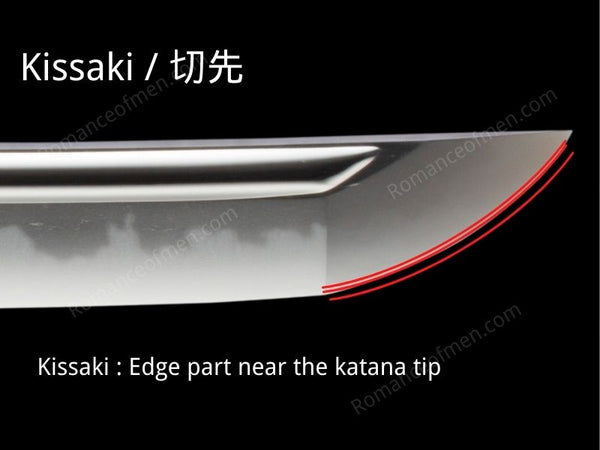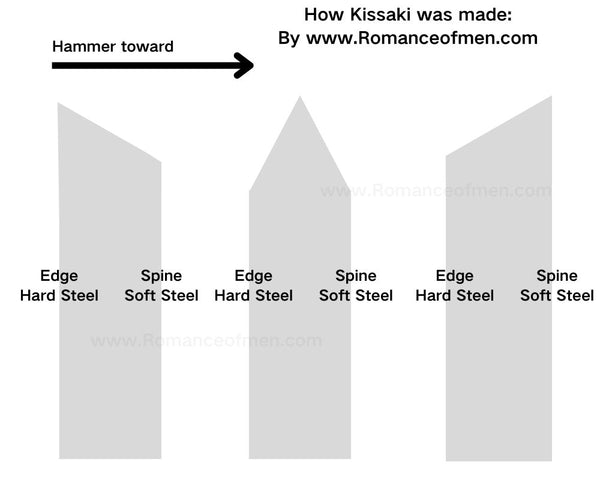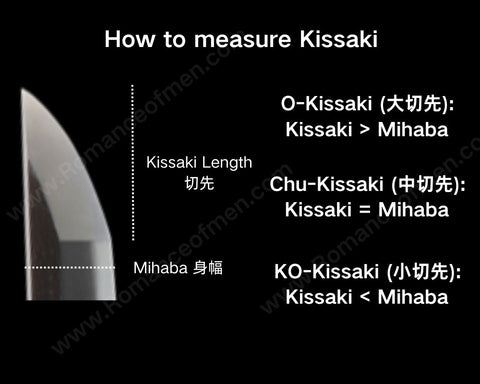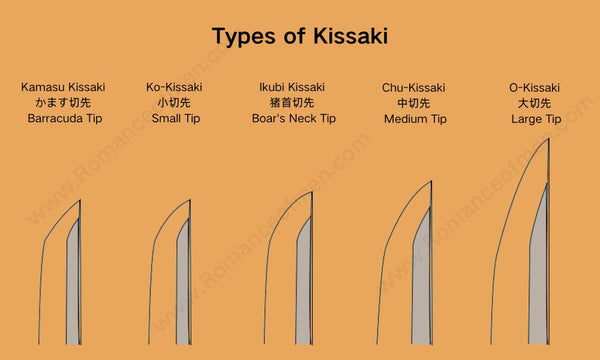What you need to know about Katana Kissaki - The tip of Katana sword
Everything You Need To Know About Kissaki
The term "Kissaki" refers to the tip of a katana's blade in Japanese. This component is very important to the katana, serving not merely functional purposes but also contributing significantly to the sword's aesthetics. In traditional katana making, Japanese Swordsmiths dedicate a lot of time and effort on the Kissaki, ensuring every detail is perfected. This article will introduce what is Kissaki, history of Kissaki, types of Kissaki and more.
Table of Content
- What Is Kissaki?
- Types of Kissaki
- History of Kissaki
- What's The Usage Of Kissaki?
- Frequently Asked Questions
What Is Kissaki?

The tip of a Katana sword is called "Kissaki" (切先) in Japanese. Another word for Kissaki in Japanese is "鋒". To be more specific, Kissaki is the section above where two specific lines meet: the "Shinogi-Suji" (鎬筋) and the "Yokote" (横手).
Kissaki is used to directly cut or stab, swordsmiths have continually improved the Kissaki to make it stronger and sharper with each battle, and shape of Kissaki evolved to meet the needs of different combat style in each era.
In traditional katana appraisal, kissaki can be seen as an extremely important part. No matter how beautifully the other parts are made, if the finishing or shape of the Kissaki is not good, the overall value of the sword will be lowered. It's fair to say kissaki is the highlight of a katana, from aesthetic standpoint.
There are some misunderstanding between the Kissaki and the Boshi, it's easy to distinguish, Kissaki is the tip, and the Boshi is the Hamon pattern within the Kissaki.
How was the Kissaki Made
There are many misleading information regarding how the Kissaki was made in traditional Japanese Katana making. Many might think that the Kissaki is simply made by grinding out a piece of metal near the tip. This might be true for modern steel katana, but for authentic katana using Tamahagane steel, this is not the case. In traditional katana making, the Kissaki was hammered into the shape, not just simply cut out.
The Kissaki was created during the Hizukuri (火造り) process. swordsmith will hammer out the katana shape in this process. And to make the Kissaki, first step is to make a diagonally cut in the spine (Mune) side, then hammer the blade side back to form the Kissaki. Here is a photo that help you better understand the process:

And formed here:
This method of making the sword tip might seem strange to many. But if you know the traditional katana blade construction, you will understand the logic behind it. Traditional katana blade is like a sandwich, the outer layer is hard steel, and the inner layer is soft steel. This construction allow the blade to have strong edge, and flexible spine that prevent breaking.
Cutting on the edge side would compromise this hard layer, exposing the softer steel beneath, which would then extend straight to the tip. Such exposure would prevent the tip from being properly hardened during the tempering process, weakening the kissaki and increasing the likelihood of breakage.
Instead, if we cut on the spine, the steel is skillfully hammered back to form the tip. This method maintains the integrity of the hard outer layer while shaping the tip, ensuring the Kissaki is both sharp and durable, capable of withstanding the rigors of use without compromising its strength.
Kissaki Length
Drawing a straight, vertical line start from Yokote to the tip of the blade, is the length of Kissaki. Most common length for Kissaki is 3-4 cm. Depends on the proportion of kissaki and mihaba, there 5 different types of Kissaki.

Types of Kissaki
Based on the length and shape, Kissaki can be classified into 5 types:

Kamasu Kissaki (かます切先 Barracuda Tip): Kamasu Kissaki is 2-3cm long and was popular from the Heian to the Kamakura periods. It's named for its resemblance to the mouth of a barracuda, and it's often found on the earliest types of Japanese swords.
Ko-Kissaki (小切先 Small Tip): Also 2-3cm long, this tip bulges slightly and is typical of swords from the Heian to the Kamakura periods. It's simply a smaller version of the tip, common in 古刀 "Koto"
Ikubi Kissaki (猪首切先 Boar's Neck Tip): Ikubi Kissaki is about 3-4cm, this style was popular during the middle of the Kamakura period. Ikubi Kissaki is often featured on Tachi, which has a wider Mihada "身幅" than Uchigatana "打刀". Ikubi means boar's neck, because the shape of Ikubi Kissaki looks like one.
Chu-Kissaki (中切先 Medium Tip): This is another medium-sized tip, 3-4cm long, found from the mid to late Kamakura period, through to the Muromachi and Edo periods. It's the most common shape among existing swords.
O-Kissaki (大切先 Large Tip): Longer than 5cm, this large tip became fashionable during the Nanbokucho period, continuing into the Muromachi and Edo periods. Swords designed for mounted combat like Tachi and Odachi often featured this tip.
History of Kissaki
As mentioned early, the shape and length of kissaki went thought many changes in the history, to adopt the battle style of different era. Here we summary and break down the Kissaki development in history:
-
Pre Nara Period : The kissaki were small and straight, without the curved shape seen in later periods. Swords from this era, known as "Jokoto, 上古刀" had no curvature in the blade itself.
-
Late Heian Period: Tachi (太刀) was invented, with a very slender shape and significant curvature (Sori) from the hilt to the middle of the blade. The kissaki were still relatively small but began to show a curved shape.
-
Early Kamakura Period: Katana continued the trend of being curved with small kissaki. However, the shapes started to become more defined with a noticeable curve.
-
Mid Kamakura Period: With the rise of the samurai class, the design of katana became more splendid. The kissaki did not taper as much towards the tip, leading to a more stubbed shape known as "ikubi" (boar's neck).
-
Late Kamakura to Nanbokucho Periods: There was an increase in the middle-sized kissaki katana. Changes in warfare tactics led to the creation of significantly longer swords, including extremely long "Odachi" katana with kissaki longer than 5 cm.
-
Muromachi Period: Early in this period, there was a return to styles similar to the early Kamakura period, with medium-sized kissaki being popular. However, the period saw various types of kissaki, including larger ones, influenced by the balance and fashion of swords.
-
Late Muromachi to Azuchi-Momoyama Periods: Katana around 2 shaku 1 sun (about 63.6 cm) became more common, reflecting changes in warfare towards more infantry-based combat and the widespread use of mass-produced swords. longer katana, up to 2 shaku 4 to 5 sun (72.7 – 75.8 cm), became popular again, with wider blades and thicker constructions.
-
Edo Period to Bakumatsu: The trend moved towards longer swords with shallow curves. Large kissaki were a significant feature of this era. Post-Meiji Restoration, with the "Sword Abolishment Edict,廃刀令" sword-making declined, except for "Gendaito" (modern swords現代刀) which imitated styles from various eras, particularly favoring the Kamakura period Tachi style.
What's The Usage Of Kissaki?
A sword's point is one of the most crucial factors that determine its worth. So a Katana's value is highly dependent on its Kissaki.
Any cuts, marks, or flaws will hurt the sword's value when buying or selling a Japanese katana. However, whether the defects are located on the blade itself or at the Kissaki can significantly impact its performance.
To use a traditional metaphor, the Kissaki represents the "face" of the sword. Hence, sustaining injuries elsewhere on the body rather than to the face is preferable. Strangely, people would call Katanas with no recognizable forge "headless" long ago and were thought to be worthless by many. That's why master artisans would craft the Kissaki with great care.
Frequently Asked Questions
- How Long Does it Take to Polish Kissaki?
Ans: Kissaki is notoriously time-consuming to polish due to their complex geometry and non-uniform shape. Polishing the Kissaki can take as much time as polishing the rest of the blade. Unlike the rest of the Katana, where large strokes work well, the tip's surface area is complex, and you can only polish it in small increments.
- What Is the Difference Between Kissaki and Boshi?
Ans: The kissaki is the sharp tip of a Katana. On the other hand, the Boshi is basically the end portion of the Hamon line that is on the kissaki.
Conclusion
The Kissaki is one of the most crucial parts of a Katana, this article has covered everything you need to know about Kissaki, from how to measure it, the history and different types of kissaki . Thanks for reading till now, and don't forget to check more katana parts in this guide.





















